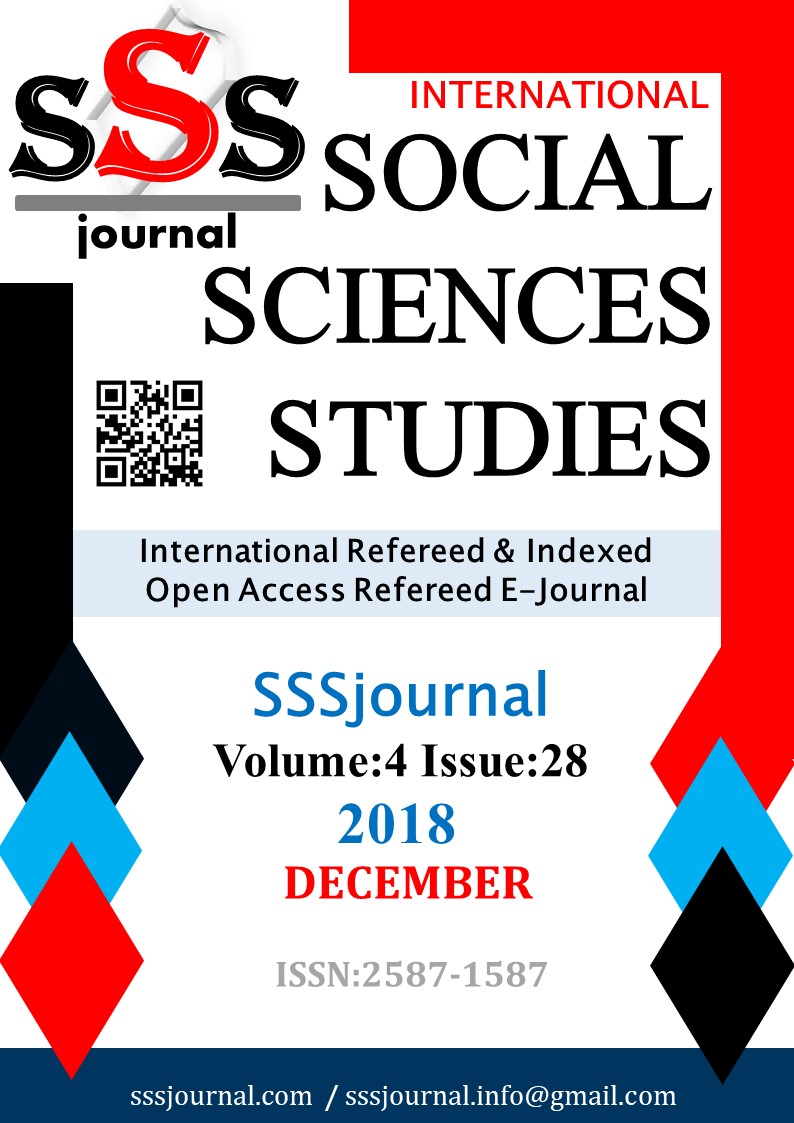Author :
Abstract
Bu çalışmanın amacı, sosyal rol kimliğini ölçmek üzere, ulusal bağlam özelliklerini dikkate alan bir ölçüm aracı geliştirilmesidir. Madde havuzunun oluşturulması ve maddelerin uzman görüşleri doğrultusunda değerlendirilmesi aşamalarından sonra, elde edilen taslak ölçek ile 230 kişiden oluşan bir örneklemden veri toplanmıştır. Söz konusu verilerle yapılan faktör analizi sonucunda ölçeğin, her biri dört maddeden oluşan iki faktörlü (Kozmopolit Kimlik, Yerel Kimlik) bir yapı gösterdiği belirlenmiştir. Daha sonra 419 kişiden oluşan bir başka örneklemden veri toplanarak gerçekleştirilen doğrulayıcı faktör analizi sonuçları, ölçeğin iki faktörlü yapısının doğrulandığını göstermiştir. Yapılan Cronbach Alfa analizi sonuçları da ölçeğin yeterli güvenilirliğe sahip olduğunu göstermektedir. Bu çalışmalar sosyal rol kimliği ölçeğinin geçerli ve güvenilir bir ölçüm aracı olduğunu ortaya koymaktadır.
Keywords
Abstract
The purpose of this study is to develop a measurement tool that takes into account national context characteristics to measure the social role identity. Data were collected from a sample consisting of 230 people with the draft scale obtained after the preparation of the item pool and the evaluation of the items in line with the specialist’s view. As a result of the factor analysis, it was determined that the scale has two factors (Cosmopolitan Identity, Local Identity) each consisting of four items.Then, the results of the confirmatory factor analysis performed by collecting data from another sample of 419 people showed that the two-factor structure of the scale was confirmed. The results of the Cronbach Alpha analysis show that the scale has sufficient reliability. These studies reveal that the social role identity scale is a valid and reliable measurement tool.
Keywords
- Carmeli, A. (2004). “The link between organizational elements, perceived external prestige and
- Carmeli, A. (2004). “The link between organizational elements, perceived external prestige and Performance”, Reputation Review, 6(4): 314-33.
- Flango, V. E. & Brumbaugh, R. B. (1974). “The dimensionality of the cosmopolitan-local construct”, Administrative Science Quarterly, 19(2): 198-210.
- Fuller, J. B.; Hester, K., Barnett, T., Beu, D., Frey, L. & Relyea C. (2009). “Extending the groupengagement model: An examination of the interactive effects of prestige, respect, and employee role identity”, Journal of Managerial Issues, 21(1): 119-139.
- Glaser, B. G. (2011). “The local-cosmopolitan scientist”, Grounded Theory Review, 10(3): 1-19
- Goldberg, L. C.; Baker, F. & Rubenstein, A. H. (1965). “Local-cosmopolitan: Unidimensional or multi- dimensional?”, American Journal of Sociology, 70(6): 704-710.
- Goldberg, A. I. (1976). “The relevance of cosmopolitan/local orientations of Professional values and behavior”, Work and Occupations, 3(3): 331-356.
- Gouldner, A. W. (1957). “Cosmopolitans and Locals: Toward an analysis of latent social roles—I”, Administrative Science Quarterly, 2: 281-306.
- Gouldner, A. W. (1958). “Cosmopolitans and locals: Toward an analysis of latent social roles II”, Administrative Science Quarterly, 2(4): 444-480.
- Grimes, A. J. & Berger, P. K. (1970). “Cosmopolitan local; evaluation of the construct”, Administrative Science Quarterly, 15: 407-416.
- Gürbüz, S. & Şahin, F. (2014). Sosyal Bilimlerde Araştırma Yöntemleri, Seçkin Yayıncılık, Ankara.Haas, M. R. 2006. Acquiring and applying knowledge in transnational teams: The roles of cosmopolitans and locals. Organization Science, 17(3): 367-384.
- Hinkin, T.R. & Schriesheim C.A. (1989). “Development and application of new scales to measure theFrench and Raven Bases of socialpower”, Journal of Applied Psychology, 74(4):561-567.Hinkin, T.R. (1995). “A review of scale development practices in the study of organizations”, Journal of Management, 21 (5): 967-988.
- Hinkin, T. R. (2005). “Scale development principles and practices”. (Ed. R.A. Swanson ve E.W. Holton), Research in Organizations: Foundations and Methods in Inquiry. Berrett- Koehler: San Francisco.
- Iverson, R. D.; Mueller, C. W. & Price, J. L. (2004). “Revisiting the cosmopolitan-local construct: Anevent history analysis of employee turnover”, Innovative Theory and Empirical Research on Employee Turnover, 55-72.
- Kelloway, E. K. (1995). “Structural equation modeling in perspective”, Journal of Organizational Behavior, 16: 215-224.
- Lammers, C. J. (1974). “Locals, Cosmopolitanism, and faculty response”. Sociology of Education, 47 (1): 129-158.
- Lawshe C. H. (1975). “A quantitative approach to content validity”, Personnel Psychology, 28: 563-575
- Shepherd, C. R. (1961). “Orientations of scientists and engineers”, The Pacific Sociological Review, 4(2): 79-83.
- Wright, T. A. & Larwood, L. (1997). “Further examination of the cosmopolitan-local latent role construct”, Psychological Reports, 81: 897-898.





